“Amity Island had everything. Clear skies. Gentle surf. Warm water. People flocked there every summer. It was the perfect feeding ground.”
When it comes to Lost Legends, we’ve tackled some giants before. From getting tangled up with a giant squid aboard 20,000 Leagues Under the Sea to escaping a rampaging T. rex on Jurassic Park: The Ride; surviving a bloodcurdling Alien Encounter to facing the rage of the gods aboard TOMB RAIDER.

But to take on the creature in today’s story, let’s just say we’re gonna need a bigger boat… Today, we’ll dive deep into the history of Universal Studios Florida’s JAWS, the sensationally terrifying ride that represented the best of Universal’s action, storytelling, and signature special effects; a twisted take on a Disney classic, this complex attraction lived multiple lives before sinking forever in favor of a magical replacement.
Let’s relive the astounding story of this headlining ride that outlived most of Universal’s classics by exploring its history, riding through its signature scenes, and seeing where it lives on today…
And before we head off, remember that you can unlock rare concept art and audio streams in this story, access over 100 Extra Features, and recieve an annual Membership card and postcard art set in the mail by supporting this clickbait-free, in-depth, ad-free theme park storytelling site for as little as $2 / month! Become a Park Lore Member to join the story! Until then, let’s start at the beginning…
JAWS
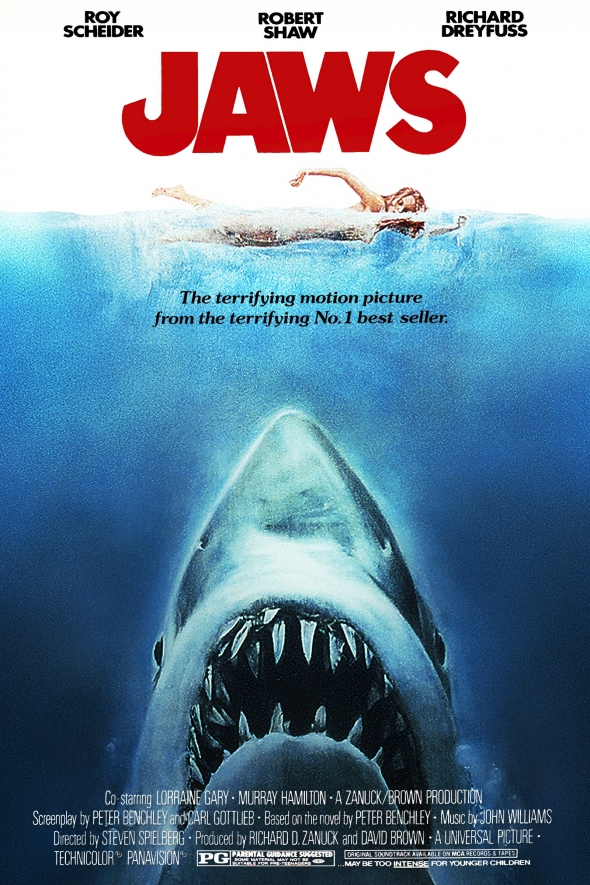
Whether it’s a parent, child, or friend, chances are that you’re within one degree of separation from someone whose interest in the beach declined significantly after summer, 1975. That’s because on June 20th, Steven Spielberg’s Jaws (based on the novel of the same name by Peter Benchley) arrived in theaters.
Sure, Jaws is considered a watershed event in filmmaking. It literally invented the concept of the wide release “summer blockbuster” that’s now industry standard, became the highest grossing film of all time (beaten two years later with another summer blockbuster: Star Wars), and was even selected by the Library of Congress to be preserved forever in the United States National Film Registry for being “culturally, historically, or aesthetically significant.” But what most people took from their first viewing of the film was an extreme disinterest in swimming.
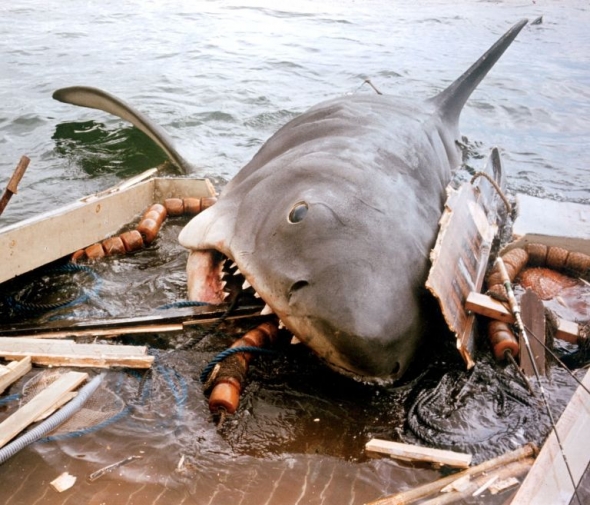
The film follows the hapless residents of Amity Island, Massachusetts (including Police Chief Brody, shark hunter Quint, and oceanographer Matt Hooper) as they contend with a bloodthirsty 25-foot Great White Shark.
Though the behind-the-scenes story of the film’s production is a labyrinth of cost overruns, frazzling and waterlogged robotic sharks, and principal photography lasting three times as long as expected, viewers only knew that the unbelievable thriller had to seen to be believed. What’s more, Spielberg’s blown budget and misbehaving sharks limited the shark’s appearances to mere suggestions and dorsal fins – in retrospect, a saving grace that gave the film Hitchcock-like nuance and suspense.
First Sighting

Universal’s Studio in Hollywood had been a movie-making headquarters under the supervision of filmmaking pioneer Carl Laemmle since 1912, introducing a headlining behind-the-scenes studio tour in 1915. This one-of-a-kind tour invited the general public to watch actual films being made, and cost only 25-cents (and 5-cents more for a boxed chicken lunch). Laemmle’s studio tour was axed in 1930, as the advent of sound in motion pictures required closed, quiet sets.
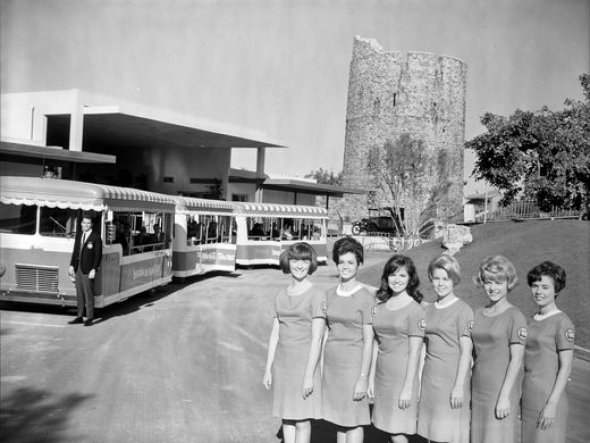
In the early 1960s, new owners MCA had the good sense to commission a new studio tour, and in 1964 Universal Studios Hollywood was officially re-launched as a theme park open to the public. The new tram-led studio tour included looks at the Studios’ historic movie sets, glimpses of actual in-production features, and even walkthroughs of famed dressing rooms of the stars. Over time, special effects, stunt demonstrations, and staged scenes began to be as much a draw as the actual behind-the-scenes spots.
So after the release of Jaws in 1975, designers acted quickly to place a Jaws scene within the Studio Tour, and by 1976 a robotic shark was terrorizing riders daily. In the simple setup, the tram would drive through a “set” from the Jaws production (actually a recreation of a Martha’s Vineyard village since the movie wasn’t filmed in Hollywood). A fisherman (later a diver) would be floating in the middle of the bay when a dorsal fin would slice through the water in the background. Before a word of warning could be uttered, the fisherman would be gone, pulled beneath the waves with blood rising from the spot where he once sat.

The tram would then make way for a pier seemingly decades old, touring along the water’s edge as, in the distance, shark bait lines and flotation barrels are dragged into the water. The lines would snag the pier’s foundations, tearing them out from underneath and sending the roadway tilting toward the water just as the great shark himself would leap out, gnashing and rumbling!
Jaws was eventually joined by flash floods, collapsing bridges, parting seas, a close encounter with Norman Bates, and more. Eventually, similarly harrowing encounters with King Kong (1986 – 2008) and an 8.3 magnitude earthquake (1988, from 1974’s Earthquake movie) joined, too.
One thing was clear: The short-but-sweet encounter with the single animatronic was a horrifying hit and quickly became the starring encounter on a tour packed with movie magic. So when Universal Studios decided to build a new movie studio and an accompanying Studio Tour in Florida, it was all-but-assured that Jaws would be a stop on that park’s tour, too. Until…
Movie Wars
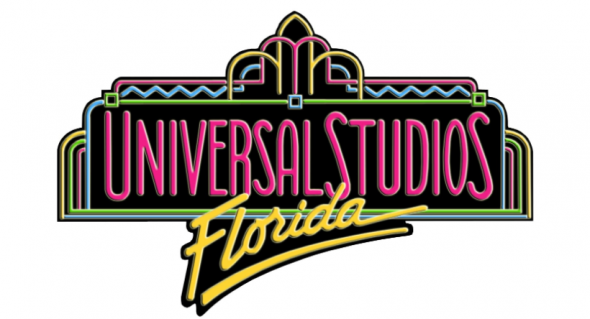
Plans for a Universal Studios Florida developed as far back as 1982, and from the start, designers planned to be ambitious. While Universal Studios Hollywood had always been a theme park within a movie studio, in Orlando Universal would build a movie studio within a theme park. Built “from the ground up” rather than the (to that time) 70-year organic growth of their California property, Universal Studios Florida would be their first chance to master-plan a park with guests, traffic flow, and a lineup of rides in mind.
Steven Spielberg himself – who served as the park’s co-founder – lit a fire under the park’s production in 1986 when the concept of a Back to the Future themed simulator ride boosted morale and implied that a Universal Studios in Florida could go head-to-head with Magic Kingdom and the brand-new Epcot. So in 1987, MCA purchased 400 acres of swampland in Orlando to build a movie-themed park centered on an East Coast version of the Tram Tour.
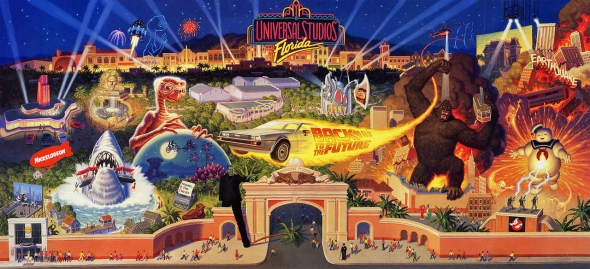
There was just one problem.
In 1984, Michael Eisner became the new CEO of the Walt Disney Company. No stranger to the world of media, Eisner had been the CEO of Paramount Pictures for the preceding decade. Eisner knew movies. In fact, it was his cinematic history that led to a period of rejuvenation within the Walt Disney Company. In film, the “Disney Renaissance” kicked off with 1989’s The Little Mermaid and continued through Beauty and the Beast, Aladdin, The Lion King, and many more.
He also brought his filmmaking prowess to Disney’s parks, forging connections with outside intellectual properties (an unthinkable act at the time) to bring new, thrilling, current brands into Disney Parks. Eisner ushered in the “Ride the Movies” era of theme park history that’s so well-known, we chronicled it in a special feature, BLOCKBUSTER: The Ride, bringing attractions themed to well-known films to Disney Parks.
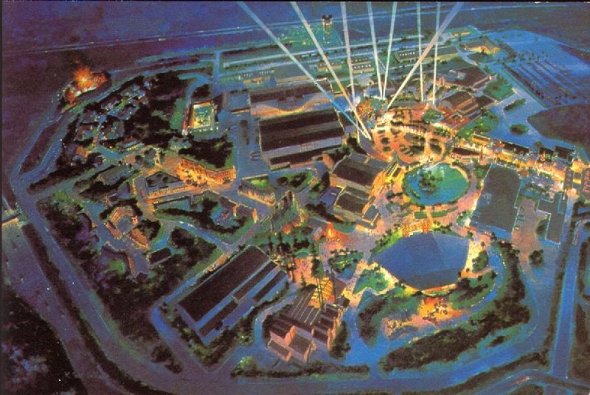
But Eisner was thinking bigger. At first, his plans called for EPCOT Center to host a Future World pavilion all about filmmaking with a lengthy and informative dark ride through the greatest licensing-accessible scenes in cinematic history. But the plans grew. Eisner and Disney Legend Marty Sklar began to consider the potential for an entire park themed to move making. And Universal’s movement in Florida made it all the more important that Disney launch a preemptive strike. A Disney-branded movie studio park in Florida might ward Universal away. So the path was set.
How could Disney’s decision to rush-order a movie park have been the impetus behind Universal Studios Florida’s lost Jaws attraction? Read on…


